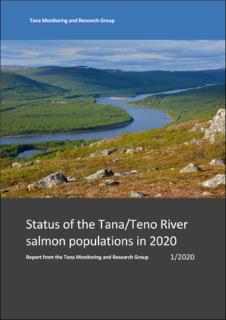| dc.description.abstract | Anon. 2020. Status of the Tana/Teno River salmon populations in 2020. Report from the Tana Monitoring and Research Group nr 1/2020.
This report is the fourth status assessment of the re-established Tana Monitoring and Research Group (MRG) after the new agreement between Norway and Finland. After a summary of salmon monitoring time series in Tana/Teno, we present an updated status assessment of 15 stocks/areas of the Tana/Teno river system. All stocks are evaluated in terms of a management target defined as a 75 % probability that the spawning target has been met over the last four years. A scale of four years has been chosen to dampen the effect of annual variation on the status.
The mixed-stock fisheries monitoring in Tana/Teno is currently undergoing a transition, moving away from microsatellite markers to single-nucleotide polymorphism (SNP) markers. The two methods are giving some diverging results, and as part of the process of increasing our understanding of the mechanisms involved, we have done separate status assessments with both genetic methods in this report.
Assessing the stock status is answering the question about how well a salmon stock is doing, how many salmon were left at the spawning grounds and how many should there have been. The question about how many salmon should spawn has been addressed by the defined spawning targets for the different populations (Falkegård et al. 2014). Several alternative ways of estimating the spawning stock are used:
1) Direct counting of spawners, In rivers with snorkelling counts during the spawning period.
2) Combine fish counting and catch statistics. In rivers with fish counts (e.g. video, sonar) and catch statistics.
3) Combine estimates of exploitation rate and catch statistics. In rivers with fishing and catch statistics but no salmon counts.
4) Combine genetic information from main stem catches, exploitation rates and catch statistics. In rivers with little/no fishing and catch statistics.
Sonar counts from the Tana/Teno main stem in 2018-2020 give direct estimates of total run size and improve the estimated exploitation rates for both the Tana/Teno mainstem and the tributaries.
The map summarizes the 2017-2020 stock status of the evaluated parts of the Tana/Teno river system. Symbol colour designates stock status over the last four years, classified into five groups with the following definitions:
1) Probability of reaching the spawning target over the last four years higher than 75 % and attainment higher than 140 % (dark green color in the summary map below)
2) Probability higher than 75 %, attainment lower than 140 % (light green)
3) Probability between 40 and 75 % (yellow)
4) Probability under 40 %, at least three of the four years with exploitable surplus (orange)
5) Probability under 40 %, more than one year without exploitable surplus (red)
Based on SNP data, eight of 15 stocks need a recovery plan with the probability of reaching management target lower than 40 %. Five stocks were placed in the worst status category with very little exploitable surplus over the last four years. The situation evaluated with microsatellites was worse with ten of 15 stocks needing a recovery plan.
Of the stocks with poor status, the most important thing to note is the status of the upper main headwater areas of Kárášjohka, Iešjohka and Anárjohka/Inarijoki and of the Tana/Teno main stem. These areas had low target attainment and low exploitable surplus. These four areas constitute 84 % of the total Tana/Teno spawning target and over the last four years, these areas together have lacked an average of 35 000 kg female spawners annually to reach their combined management targets.
Exploitation estimates show decreasing exploitation for most individual salmon stocks in the mixed-stock fishery in the Tana/Teno mainstem following the 2017 agreement between Norway and Finland. The extents of the reduced exploitation rates are however diverging considerably both between rivers and between assessment methods and we urge precaution in management decision-making in the coming years. We expect most of the diverging results to be resolved in 2021.
To summarize, the overall stock status in most salmon populations of the Tana system in 2020 is poor. Estimated salmon returns and spawning stocks were low and even all-time low for some rivers. The prospects for 2021 salmon run are rather low and therefore the fishing pressure should be kept as low as possible to enable stock recovery. | en_US |
